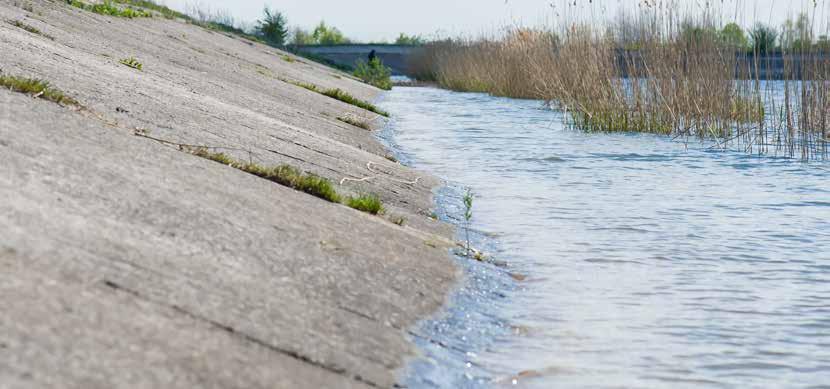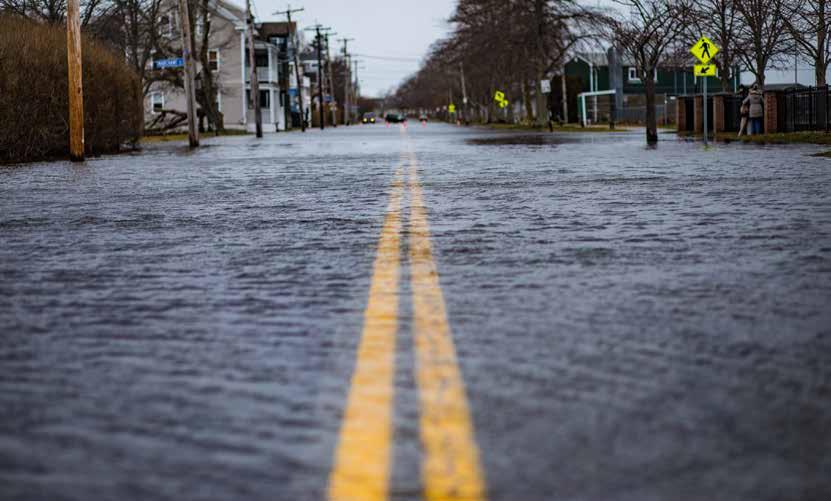
12 minute read
Table 4.1. Unique characteristics of NbS compared to grey infrastructure
4
The need to adjust traditional enabling environments to foster the use of NbS
The discussion of application areas of NbS to reduce water-related risks shows a rich set of options available to use and enhance nature as an effective resilience building measure, both alongside grey infrastructure or as self-standing solutions. It additionally highlights that NbS can be physically effective, cost-efficient and multifunctional.
While the review of applications is not a comprehensive assessment of the extent to which OECD countries have implemented NbS to manage water-related disasters, is does give an indication that the majority of NbS implemented on the ground have been launched as one-off projects. This is reinforced by recent studies which have found that NbS are usually implemented on a pilot basis and in an ad hoc way (Kapos et al., 2019 [4] ; Browder et al., 2019 [5] ; Trémolet S. et al, 2019 [6] ; Wingfield et al., 2019 [73] ). These projects tend to benefits from vested supporters, but often lack the policy and financial framework to apply them more systematically, more frequently, and at larger scale. The following section discusses the characteristic of NbS which makes them unique from grey infrastructure, followed by how current policy environments consider NbS.
NbS have fundamental characteristics and requirements which differentiate them from grey infrastructure (see Table 4.1), such as long time scales until intended benefits develop, large spatial scales, dynamic uncertainty, and diffused benefits. These characteristics, can lead to NbS being a “bad fit” for decision making within institutional, regulatory and financial processes that have all been developed with grey infrastructure in mind. Traditional enabling environments (institutional, regulatory and financial) can therefore inadvertently discourage the use of NbS.
While NbS do not always emerge through traditional enabling environments for reasons discussed below, some of the unique characteristics of NbS are well suited to recovery measures. For example, while it can take longer for the full intended benefits of an NbS to materialize (such as decreased erosion and improved water quality), their initial steps, such as restoration, can be quick to implement requirements (Hepburn et al., 2020 [36] ). In addition, while it can be difficult to measure (and capture) co-benefits, the ability of NbS to achieve multiple policy goals with one intervention can make them particularly appealing public investments.
Time scales
Some NbS, especially those involving the restoration of badly degraded ecosystems, can be slow to develop their adaptation benefits or deliver potential co-benefits in full. While grey infrastructure reach their desired protective benefit immediately upon finalisation of
TABLE 4.1. Unique characteristics of NbS compared to grey infrastructure
Characteristics
Time scales
Spatial scales
Performance reliability
Quantification of benefits NbS
Long time horizons for benefits to materialise
Often implemented at landscape scale to be effective, crossing jurisdictional boundaries
Performance uncertainties are can be unknown due to complex natural systems
Many co-benefits difficult to quantify (e.g. human health and livelihoods, food and energy security biodiversity) Grey Infrastructure Benefits are realised straight after construction
Implemented “within the fence line” of jurisdictions
Performance uncertainties are “known”
Benefits easy to quantify (e.g. avoided damage to assets)
construction, the growth rate of the living components, such as forests, takes much longer to fully reap their full protective benefit. (Kabisch et al., 2016 [25] ). At the same time, the adaptability of NbS over time make them appreciate in value as opposed to the high depreciation costs associated with grey infrastructure. The challenge though is that NbS may not yield the risk reduction effects in the time frame policy makers would hope for (World Bank, 2017 [74] ).
Spatial scales
The spatial scale considered for planning NbS substantially affects their ability to deliver expected outcomes. The integrity and health of ecosystems at landscape scales determine the potential of NbS to be effective, as ecosystems are highly dependent on the larger enabling environmental processes (Calliari, Staccione and Mysiak, 2019 [75] ). For example, the alteration of upstream sediment loads may influence downstream coastline stability, which in turn determines the success and feasibility of downstream or coastal interventions. Often, NbS cannot be sustained by managing individual sites in isolation, as the delivery of associated ecosystem services might depend on processes taking place on a larger scale (World Bank, 2017 [74] ). In some cases, a certain size of ecosystem may be needed for it to be resilient to various pressures and therefore continue to provide services in future. However, the appropriate scale is unique to each NbS. For example, empirical evidence suggests that natural water retention measures can be effective in small catchments, but may not have the same effectiveness when up-scaled to larger areas (Collentine and Futter, 2018 [76] ). Finally, there are inherent tradeoffs in the use of NbS as the space dedicated to NbS often implies the land cannot be used for another productive use.
Performance reliability
Ecosystems are not static, as they are made of living components that change over time. This can be a benefit, as it means NbS can adapt to changing environmental and risk conditions, thereby potentially exceeding the design lifetime of grey infrastructure (World Bank, 2017 [74] ). However, the dynamism of NbS also introduces new sources of uncertainty, which can increase the difficulty in developing solid predictions about the level of service provided.
NbS implemented for climate adaptation purposes may themselves be climate-sensitive. For example, coral reefs However, the Intergovernmental Panel on Climate Change (IPCC) Special Report on Global Warming of 1.5C found that between 70 and 90 per cent of coral reefs would be lost if the temperature increased to 1.5C, and more than 99 per cent if temperature increased by 2C (2018 [77] ). Peatlands, as another example, provide valuable ecosystem services through flood management and carbon sequestration (Shuttleworth et al., 2019 [78]) , but are highly sensitive to climatic change (Bonn et al., 2016 [79] ). Therefore the success of NbS can only be achieved by ensuring management and restoration approaches take into account anticipated climate impacts as well as the tolerance of ecosystems to these impacts (Kapos et al., 2019 [4] ).
Quantification of benefits
In addition to their primary purpose, NbS generate ancillary social, economic and environmental cobenefits related to human health and livelihoods, food and energy security, ecosystem rehabilitation and maintenance, climate adaptation and resilience, and biodiversity (Browder et al., 2019 [5] ). While these cobenefits can be of great interest to the general public, the government and affected communities, they are often not reflected in the benefits assessment of traditional infrastructure investments. The existing methods for assessing, valuing and monitoring these co-benefits are often underdeveloped or challenging to apply (Trémolet S. et al, 2019 [6] ). There is additionally a wide variation in the hydrological and other services delivered by different ecosystem types (WWAP, 2018 [31] ), and specific costs and benefits of different solutions are dependent on local circumstances (Brown and Mijic, 2019 [40] ). Finally, there can be trade-offs between different ecosystem services. For example, enhancing the recreational capacity of a park may lead to pressures on its biodiversity through more intense use and associated disturbances.
POTENTIAL BLOCKS IN EXISTING INFRASTRUCTURE PLANNING AND INVESTMENT DECISIONS
Decisions around planning, implementing, operating, financing, and engagement for risk reduction infrastructure may need to be adapted if NbS are to be applied consistently and considered on an equal footing as grey measures. Box 4.1 highlights how prevailing decision-making frameworks could potentially prevent NbS from being considered and selected as a viable option to manage water related risks. As NbS are not systematically considered, this then leads to ad hoc projects, which in turn contributes to a low track record

The majority of implemented NbS have been launched as one-off projects.
for NbS, with sparse and case-specific performance data. A critical challenge persists for NbS in the availability and accessibility of the necessary performance data, which may not be collected at all, may be collected inconsistently or incompletely at different times, or across different spatial scales (Bush and Doyon, 2019 [80] ). Authorities charged with managing risks to communities will likely default to better known and tested solutions, in the absence of robust performance data for NbS (Dadson et al., 2017 [81] ).
BOX 4.1. The characteristics of NbS can limit their consideration by governments, local authorities or the private sector
when addressing water-related risks
Stage of infrastructure development
Planning and prioritisation of intervention
Implementation of intervention
Operation and maintenance of intervention
Securing financing
Stakeholder engagement
Monitoring and evaluation Example of how the unique characteristics of NbS can limit their consideration
Delays to the accrual of benefits due to time scales mean that benefit-cost ratios are variable over time, oftentimes resulting in traditional cost-benefit assessments leading to skewed results for NbS. Assessing technical performance of an NbS, as well as its interaction with grey infrastructure, can be imprecise due to the inherent dynamism and complexity of natural systems.
The dynamism of NbS can lead to policy makers, regulators and/or permitting agencies prioritising grey infrastructure over NbS because it is familiar and easily understood with respect to compliance and permitting.
Large spatial scales often mean NbS cross jurisdictions as well as sectoral responsabilities, causing confusion over responsibility. NbS often require the active support of local citizens and landowners, for example through tasks such as replanting trees or maintaining water retention structures. This is in contrast to the long-term operations and maintenance of grey infrastructure is typically the direct responsibility of the service provider. A reliance on a multitude of stakeholders can create additionally uncertainties about performance over time.
Diffuse benefits can render it challenging for private investment to create suitable revenue streams when many of the potential co-benefits are not traded in the market. In addition, the combination of inherent ecological dynamism and long timescales can create challenges with setting a payment schedule among beneficiaries, which can pose challenges to investors seeking short- or medium-term returns. Finally, most existing funding models do not match well to the need for continuous low-level investment over long time frames that characterise NbS.
Large spatial scales often require interventions that involve multiple stakeholders. The cost of engaging and negotiating with multiple stakeholders, working across regulatory jurisdictions and collaborating with dispersed landowners can be time consuming and costly. In addition, those responsible for providing the adaptation service (such as a flood management authority) may not have the capacity or legal legitimacy to engage with landowners.
Monitoring green infrastructure that covers large spatial areas may require data collection and analysis across sectors as well as coordinated processing communication among agencies at different governance levels. Monitoring ecological trends may require a different set of expertise and metrics than would be used for conventional infrastructure.
Sources: Browder, G. et al. (2019), Integrating Green and Gray, https://openknowledge.worldbank.org/handle/10986/31430; WBCSD (2017), Incentives for Natural Infrastructure, World Business Council for Sustainable Development; Lukasiewicz, A., J. Pittock and M. Finlayson (2015), Institutional challenges of adopting ecosystem-based adaptation to climate change, Regional Environmental Change, http://dx.doi.org/10.1007/s10113-015-0765-6.; Kapos, V. et al. (2019), The Role of the Natural Environment in Adaptation, Background Paper for the Global Commission on Adaptation, Global Commission on Adaptation, Rotterdam and Washington, D.C
5

National governments play a key role in fostering the use of NbS. Governments need to design an institutional, policy, regulatory and financial enabling environment that facilitates the take up of NbS by both public agencies across levels of government as well as private actors. It is important for national governments to ensure that governance arrangements, regulations and technical capacity do not inadvertently discourage their use. In the following section, a scan of current policy provisions for NbS across OECD countries is provided. The scan focuses on national adaptation plans and strategies as well as a complementary OECD survey. To get a more complete picture of the integration of NbS in national policy frameworks, and their implementation progress in water-related risk management, other policy documents, regulations and financing mechanisms need to be additionally examined. In-depth country case studies will be carried as part of the OECD work on NbS to provide a more comprehensive assessment for a selected set of countries.
National adaptation plans provide a good entry point to understanding the policy priority given to NbS as an adaptation measure in OECD countries. National adaptation plans bring together countries’ policy priorities and suggested actions as part of the national policy agenda for climate change adaptation, of which water-related risks are a key part. Table 5.1 shows that out of the 35 OECD 4 countries that have national adaptation plans or strategies, 24 directly mention NbS 56 .
References to NbS range from countries simply stating that they recognise the importance of these approaches as part of climate change adaptation, to the explicit reference of using NbS for addressing specific hazards. For example, when looking at the national adaptation plans for Japan and Poland, NbS are stated as being valuable approaches that will become increasingly important due to intensifying climate impacts. In the cases of Australia, Canada, Denmark and Norway, specific NbS are referenced as being important approaches that can complement grey infrastructure in certain sectors, with wetlands and urban greening being two examples. Australia stands out in that the plan mentions the suitability of NbS in the areas of coastal, river as well as urban flooding. In the absence of coasts, Hungary is another example where NbS feature prominently in their national adaptation policy framework. Their use is suggested in the areas of riverine and urban flooding as well as to address drought risk.
Despite the fact that the majority of OECD countries have incorporated the concept of NbS into their national adaptation plans, very few suggest more concretely how NbS should be features in implementation. Only six countries make such references to concrete implementation measures, such as the creation of policies mandating the use of green drainage systems, the monitoring of ecosystem services, and proposing policies requiring the use of natural flood prevention mechanisms. No national adaptation policies contain quantitative and measurable targets relating to NbS deployment and performance.
Apart from national adaptation policies, a 2019 OECD survey on the implementation of the OECD Recommendation on Water suggests that NbS feature quite prominently in water management strategies, and many countries seem to be using NbS to address water quality, quantity (i.e. water scarcity) as well as flood risk management issues. The survey found that 23 out of 27 country respondents include NbS in their water management strategies (OECD, 2020 [85] ). Seventeen countries put forward that NbS are being used for water quantity management, while 18 countries use NbS for flood risk management. Examples of other uses included managing storm water and rainwater harvesting (Figure 5.1 – page 18).
In addition to national adaptation plans, there are of course many other policy instruments that aim at facilitating their use in different policy areas such as water management and land-use planning. For example, the EU Floods Directive (2007) promotes nature and risk-based adaptation planning opposed to technological hazard mitigation. A 2019 study found that this directive has




